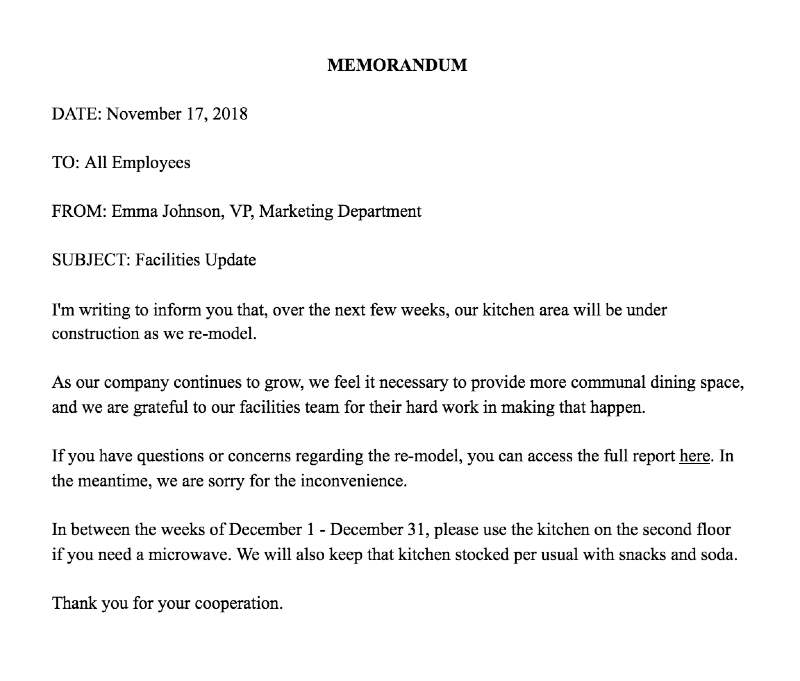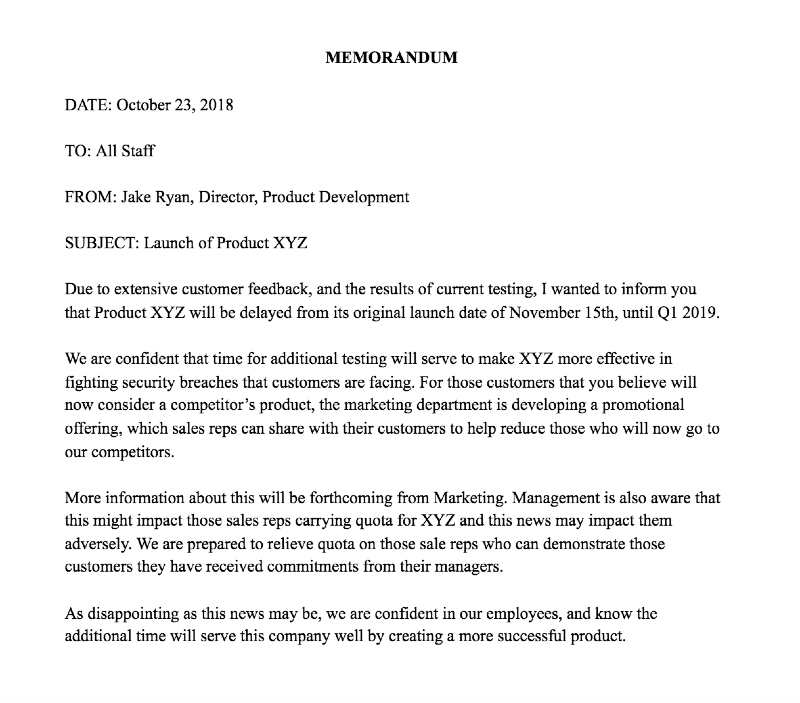Complete guide outlines how to write a memo and the step-by-step guide for the format of a business memo that is clear and has impact.
Find more business guides, tips and advice
The term “memo” refers to a document that is used for information or decision-making and is usually written for supervisors and colleagues. In some companies , such documents are also called “template”, “statement” or “note”. The format of a memo varies. Usually memos are no longer than four pages, although we’ve seen templates with more than 30 pages!
How to write a memo: step by step
Before you go through the step-by-step instructions for how to write a memo, one remark: The aim of a good memo should be to describe the underlying problem or situation as precisely and objectively as possible. So concentrate on the essentials, because the topic of your memo is usually just one of many problems that preoccupy your manager or colleagues.
How to save a business in crisis
Step 1: Answer the key questions
Before you start writing, you need to clarify some basic questions that are crucial for how to write a memo with impact:
- Who are the recipients? How much prior knowledge do you have?
- When is it necessary to explain the background or context and when not?
- How important is the topic for the recipient (is it “loved” or “hated”)?
- How would the recipient like to be informed? Is the recipient an eye or ear person, i.e. does he prefer to take information in writing or orally?
- Does the recipient ask for detailed information or just a summary?
- Is the recipient fact-based or not?
- Who has to comment on the topic or contribute their point of view, such as their own superiors, superiors from other departments, colleagues from their own department, colleagues from other departments and external experts (lawyers, consultants, tax consultants, experts …)?
Step 2: State the priority of the topic
The recipient must be able to classify the problem or issue immediately. So first try to specify the priority. For classification I recommend the so-called “Eisenhower method” (named after the US American General and President Dwight D. Eisenhower).
This results in the following combinations of importance and urgency:
- Type 1: hurried but of little importance;
- Type 2: hurried and very important;
- Type 3: low urgency, but great importance;
- anything else is not suitable for memos.
Step 3: Write a concise subject line
The importance of the subject line should not ever be overlooked in how to write a memo that gives a clear communication. Describe the problem or issue briefly and precisely, ideally as a question. So not: “Restructuring the sales system”, but: “How should we restructure our sales system?”
Because it always applies: Memos are used for information or decision-making, they should be short and precise. As a rule, the following applies: as detailed as necessary and as briefly as possible.
Step 4: outline your concern
Before you begin the actual discussion, you should let the recipient know what to expect from them.
As a recipient, you read a text differently when you know that something needs to be decided than when you just need to take note of something. For example, you could use the following categories: “Take note”, “Decide by …”, “Have a conversation” or “Take action”.
Step 5: State the problem or issue
Given the variety of topics that can be discussed in memos, it is difficult to recommend a general outline. However, it is always helpful to use W-questions to check whether you have mentioned all important aspects: Who? What? When? Where? How? Why? By which? How long?
If your memo is longer, you should summarize essential statements in (active form) subheadings. Also write an executive summary to precede your remarks. Memos should not only convey information, but also reflect your own opinions and assessments in order to force decisions.
If you write to several recipients who are differently familiar with the underlying topic, you can separate detailed and further information in attachments. For example, a history or prehistory, calculations, legal bases or details of alternative solutions are suitable (see step 7).
Step 6: Classify the problem or the issue
After you have described the problem or issue, you should go one step further and try to relate the topic to corporate strategy or profit target.
What exactly does that mean? As already mentioned, the recipients of memos are usually the line manager. And they think strategically and profitably (at least they should). Therefore, always show – if possible – how your proposal will help implement the corporate strategy or increase profits.
Step 7: Name alternative solutions with advantages and disadvantages
Now the most exciting part for the recipient follows, namely the part in which you submit your proposed solutions. Here are a few tips:
- Find meaningful terms for alternative solutions (for example “minimal solution”, “comfort solution” or “economy package”).
- Remember that the alternative solutions should differ significantly from one another.
- Limit the “solution space” – do not work out too many variants.
- Tell me what it takes to implement the solutions – in terms of time, money and personnel.
- Use a graphical representation (such as a decision tree) to explain.
Step 8: Name the alternative of not acting
Often one possibility is overlooked when presenting solutions: namely that of doing nothing. Sometimes this can be a sensible alternative. So tell me what happens if the problem isn’t solved. Review the pros and cons of inaction.
Work with scenarios and categories
It may also be useful to draft scenarios (“best case”, “worst case”), that is, to forecast how a problem or situation will develop if nothing is done.
As a reminder, the recipient of your memo will read your text very differently when he or she knows that something needs to be decided. That is why I have already recommended that you use different categories such as “Take note”, “Decide by …”, “Have a conversation” or “Take action”.
Longer memos
This means that if your memo is longer, you should summarize essential statements in (actively formulated) subheadings. Also write an executive summary to precede your remarks.
Step 9: Make a recommendation and state the next step
Finally, your judgment is required in how to write a business memo that requires the recipient to take an action. Make the recipient’s decision easier by advocating an alternative. Justify your opinion with conclusive arguments and examples.
Your own point of view
If you cannot make a clear decision on a possible solution or if other departments or colleagues may have a contrary opinion, then for the sake of fairness state all points of view.
Give an outlook!
In order to speed up the decision-making and implementation process, you should also make it clear what is to be done in the next step by whom and when. Finally, give an outlook:
What does the “final state” look like? For example: “If we manage to implement the new sales system by the end of 2011, we will be able to increase our market share by 30 percent.”
Step 10: correct your memo
As with letters, emails and other types of text, the last step is a correction, also here with regard to content, spelling, punctuation, style, comprehensibility and form. Now ask yourself the most important question:
Does my memo make it easier for the recipient to make a decision or to understand? If you can answer “yes” then you are allowed to circulate your memo. If you have any doubts, you have to lend a hand again.
In summary:
1. Keep it simple
No matter how important information is in store, if you bury it under a mountain of trivialities, no one will read it. Get to the heart of your concern and don’t write long around it.
2. Be brief
The surest way to pave the way for your memo in the trash is a hefty extra length. Nobody likes reading long business news. Be as brief as possible, but be sure to provide your readers with all the important information.
3. Write for your target audience
Think about the addressees of your message. Avoid technical terms or exotic foreign words. Complicated, incomprehensible concepts and big words will not impress your readers, you will only bore them.
4. Anticipate the questions in your text
Read your draft text carefully and consider what questions the reader may be asking. Then sit down again and answer these questions in the revised version.
5. Assign a priority
It helps the recipient if he can assess the urgency of a document. Therefore try to assign a priority, for example according to the Eisenhower principle, that works with urgency and importance. If something is not so urgent, but important, you can also give the recipient a deadline for a response.
Memos examples for business
If you are using Microsoft Word, you will find templates for examples of business memos at https://templates.office.com/en-au/memos. You can adapt them to suit your needs, as we have done with each example of a business memo below.







